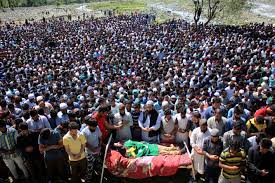The killing of militants may be seen by those sitting in Delhi as a “success” for the security forces but the fact is that these deaths have strengthened separatist sentiment in the Valley.
The killing of 13 militants in South Kashmir’s Shopian and Anantnag districts on Sunday is, to all appearances, a major success for the security forces. Some TV channels also termed it a “major boost” for the ruling party, the Bharatiya Janata Party (BJP), ahead of next year’s general elections. But on closer look, we find that it is by no means a setback for the separatist movement. Rather, it is the opposite.
The armed conflict, which has been going on for the past 30 years, has undergone a major change. In the first 10 years or more, bomb blasts, cordon-and-search operations, fire-fights, political assassinations and such other incidents were a daily occurrence. All that has changed now. Where there used to be 3,000 militants active across the state, the number has come down to a couple of hundred. On occasions when the security forces wanted to give themselves a pat on their shoulders, they would call it “residual militancy.” But now a perception is being created – with the help of an ill-informed and unprofessional media in Delhi – that the security forces are facing a huge challenge in the state again. This has led to a fatal misunderstanding of the Kashmir situation among ordinary people in India and, perhaps, also among policy-makers in Delhi.
There is no denying the armed conflict. But it’s now part of a bigger campaign – involving popular resistance. The change started with the Amarnath temple land row in 2008, when up to half a million people would join protest marches. It was in that year that tens of thousands of people marched towards the Line of Control in Uri. The next two years saw similar protests for months together. But by far the worst kind of unrest happened after the killing of a militant commander , Burhan Wani, in 2016. Tens of thousands of people took to the streets; about 100 fell to bullets, thousands of others were injured and hundreds blinded in one or both eyes by pellets fired by the police and paramilitary forces.
People have joined the funerals of militants in large numbers in the past as well but such outpouring of support for a militant commander was seen for the first time. Also, months before, a new trend had become noticeable – of ordinary people gathering near the site of an encounter to express solidarity with militants or even help them escape. All this is significant because the sudden increase in public support for militants in Kashmir is in inverse proportion to the decline in their numbers. This is reminiscent of the initial days of the armed conflict when militants became part of the folklore and women would sing of them during weddings.
Villagers offer funeral prayers of LeT commander Bashir Lashkari in Sopshali Kokernag in South Kashmir on July 2,2017. Credit: Vikar Syed/File photo
A noteworthy feature of the post-Burhan Wani unrest was that young boys, most of them in their early teens, came face to face with the police and paramilitary forces. They threw stones at them, unmindful of the fact that the police and paramilitary forces carried guns and could kill them or hurt them in the eyes. They appeared ready to die or much worse – lose their eyesight.
In short, the youth of Kashmir are angry. They are frustrated because the Centre has hardly ever during the past decade shown the will to address the problem in Kashmir.
Former Prime Minister Atal Bihari Vajpayee, and after him Manmohan Singh, came close to finalising a deal with Pakistan but the whole process came to naught after the departure of Pakistani president Pervez Musharraf. Relative peace prevailed in the valley for more than five years before Wani’s killing but the Central government – whether headed by Congress or BJP – did not launch any political initiative to resolve the issue. The UPA government appointed a three-member committee of interlocutors, headed by prominent journalist Dileep Padgaonkar. But the committee’s report has been gathering dust. Shortly before his death, the late Padgaonkar wrote to me: “Kashmir, as you can well imagine, has been on my mind without respite. Someone asked me if I saw any light at the end of the tunnel. I said that I could not spot the tunnel in the first place. Do you?”
Instead of trying for a political breakthrough during the years of peace, the BJP government talked of setting up exclusive colonies for sainiks (army men) and migrant Pandits (who were forced to flee the valley three decades ago) and pressed the state government hard to identify land for the same. This, along with the declining number of Muslims in the state’s Jammu region, as reflected in Census reports, triggered insecurities and uncertainties among ordinary people in the Valley about their future. What ever the validity of these concerns, it became an added factor in the renewed pull of militancy.
Everybody in Kashmir knows that these militants are no match for the Indian army and paramilitary forces. Against every soldier, four militants or even more have died on an average. But by dying in clashes with the army, these militants inject life into the separatist movement. The point being missed by many observers in Delhi is that three civilians died (a fourth was reportedly used as a human shield by the troops) and another 50 suffered injuries in clashes with security forces while they showed solidarity with militants during the encounters on Sunday.
The army’s hardline policy towards civilians who rush to encounter sites appears to have the support of a majority of the Indian people. They say this is the right response. But the perception in Kashmir is that the army is at war with ordinary people in the state. This is where the slain militants have succeeded. They have been killed but there can be no denying the fact that separatist sentiment has grown stronger.
Altaf Hussain is a freelance journalist. Formerly North India Correspondent of the BBC, he has also worked with the Times of India. He tweets at @ayhussain





